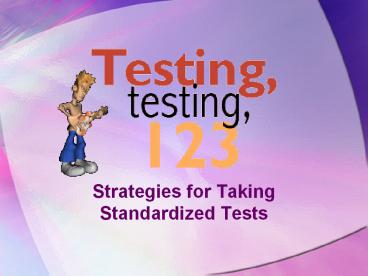Strategies for Taking Standardized Tests - PowerPoint PPT Presentation
Title:
Strategies for Taking Standardized Tests
Description:
The CRCT is a series of state-mandated tests for students in grades 1-8. In grades 3-8, the subject areas covered are Reading, English/Language arts, ... – PowerPoint PPT presentation
Number of Views:185
Avg rating:3.0/5.0
Title: Strategies for Taking Standardized Tests
1
- Strategies for Taking Standardized Tests
2
What is the CRCT?
- The CRCT is a series of state-mandated tests for
students in grades 1-8. In grades 3-8, the
subject areas covered are Reading,
English/Language arts, Math, Science, and Social
Studies. - The CRCT measures how well students have acquired
the knowledge skills outlined by the state
curriculum for their grade level.
3
The Purpose of the CRCT
- To ensure students are learning
- To provide data to teachers for better
instructional decisions - To measure accountability
- To identify individual student strengths
weaknesses.
4
STANDARDSEach student is measured on his or her
achievement in meeting the standards.
- Scores are reported according to three
performance levels. - Does not meet standards
- Meet standards
- Exceeds standards
5
Twas the Night Before Testing
- Go to bed on time.
- Put a few 2 pencils in your book bag.
- Dont worry. Your teachers have well-prepared
you for this test!
6
The Morning of Testing
- Eat a good breakfast.
- Think of something fun to do after you get home
from school. - Think Positive! You CAN do it!
7
Multiple Choice Questions
- Listen carefully to directions.
- Read the question and all answer choices before
marking anything.
8
Pace Yourself
- Answer the easiest questions first, but be sure
to go back to those questions you skipped. - Dont spend too much time on any one question. Do
your best and then move on.
9
Multiple Choice Questions
- Do not change your answers unless you are very
unsure about your first answer choice. - Try to answer every question. Make the best guess
you can.
10
The Process of Elimination
- After you have been through all of the questions
once, go back to the hard questions and eliminate
the choices that you know are not correct.
11
Skip, Return, Check
- If you finish early, check to make sure you have
answered all questions.
12
Key Words
- Find key words or phrases in the question that
will help you choose the correct answer.
13
Are we communicating?
- READ each question carefully.
- What is the question asking?
- Eliminate wrong answers.
- EXAMPLE
- What did Christopher Columbus discover?
- A. He was an explorer.
- B. In 1492 he sailed the ocean blue.
- C. He discovered North America.
- D. He is from Spain.
14
Reading Passages
- If the test requires you to read passages and
then answer questions about what you read,
read the questions first.
- By doing this, you will know what you are looking
for as you read. This also helps you go faster
on the test.
15
Reading Passages
- When there are several questions about a reading
passage or chart, look for clues in other
questions that will help you with those items
about which you are unsure.
16
Math Computation
- When using scratch paper on a math test, double
check to make sure that you have copied the
problem correctly from the test booklet!
17
Math Computation
- Line up place value correctly on your scratch
paper (thousands, hundreds, tens, ones) or the
answer will be incorrect.
18
Math Computation
- If your answer does not match one of the choices,
reread the problem, recopy the numbers, and try
solving it again.
19
A Matter of Time
- If any time remains, spend it on those questions
about which you know nothing or almost nothing. - As you go back through, do not change all
answers. - Remember Your first guess is usually right.
20
Final Tips
- Fill in bubbles fully, write neatly, and erase
stray marks. - Double-check the test number in your test booklet
against the answer sheet every few questions to
be sure you havent gotten on the wrong number.
21
The Death Grip
- If your arm tires during testing it is probably
due to the grip that you have on your pencil. - Relax the grip and give those muscles a break.
- Do not do arm exercises during testing as this
disturbs others.
22
This is NOT a Race!
- Do not go too fast or too slow. Keep a steady
pace - Remember it's okay not to know everything You
are not expected to know all of the questions.
23
Test-Taking Tips
- Relax by taking slow, deep breaths.
- Make sure you understand the directions. If you
are not sure, make sure you ask the teacher for
clarification. - Read each question carefully.
- When you use scratch paper, make sure you copy
the problem correctly from the test onto your
paper. - You can underline and make marks on your test to
help you while you work, but the only answers
that will be scored are those in the correct
place on your answer. - Try to come up with your own before seeing the
choices. - Eliminate answer choices that you know cannot be
right. - Manage your time. Dont let the pace of others
make you nervous. - Do spend too much time on one question.
- Be sure to answer all of the questions
- Review your answers when you have finished the
test in that section only. - Try to stay calm during the test. You can do it!
24
Always remember.
- A great attitude during testing will help you do
better! - YOU CAN DO IT! Yeah!































